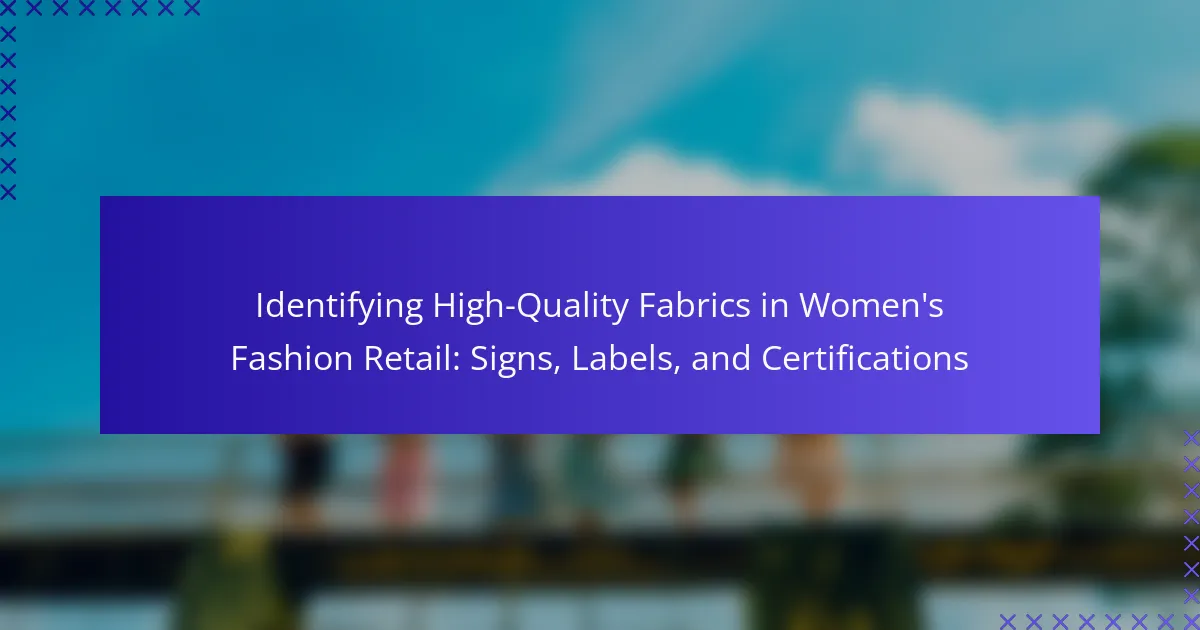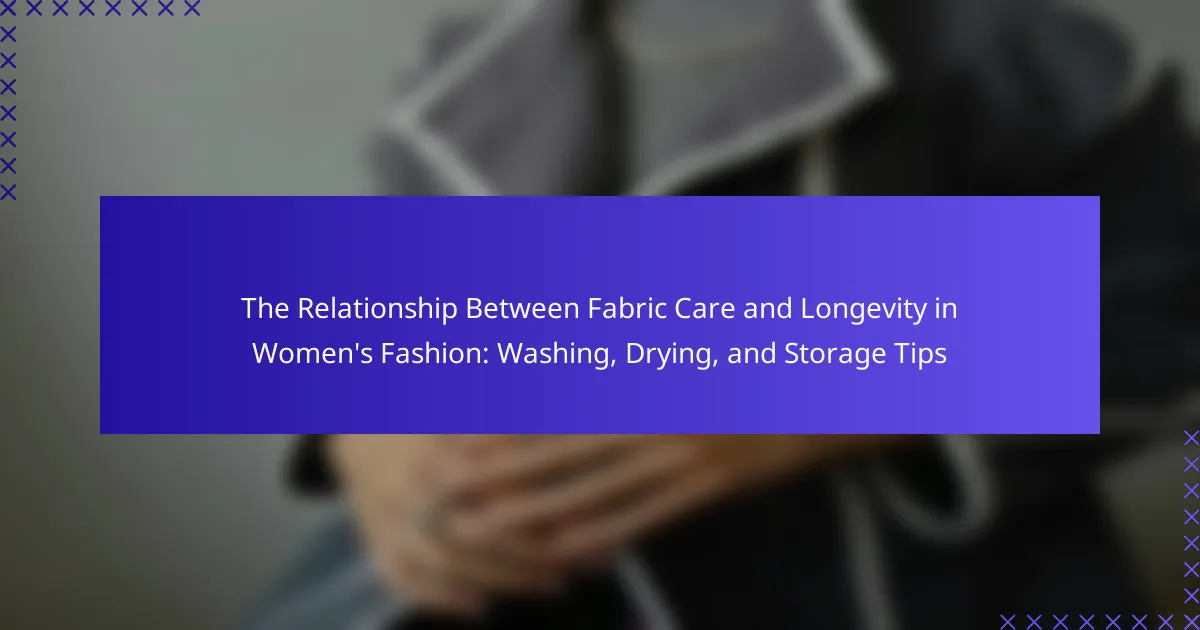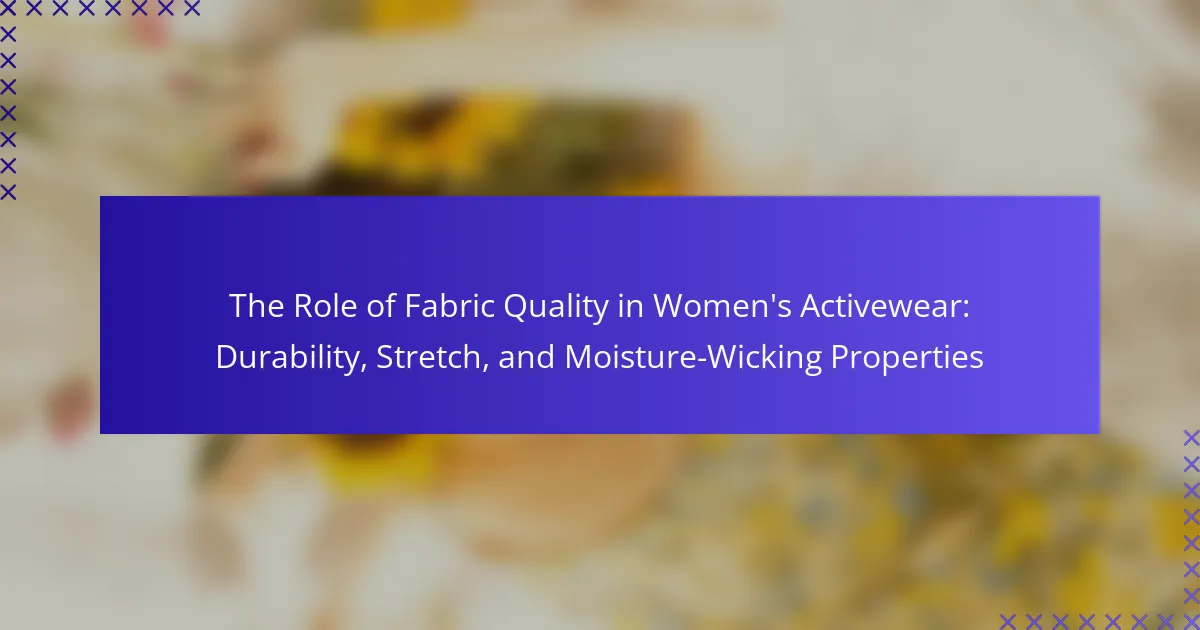High-quality fabrics are essential components in women’s fashion retail, characterized by their durability, texture, and aesthetic appeal. Common materials include natural fibers such as silk, wool, cotton, and linen, each offering unique benefits like strength, warmth, and breathability. This article provides insights into identifying high-quality fabrics by examining key signs, labels, and certifications that indicate superior fabric quality. Understanding these elements will help consumers make informed choices when selecting garments that not only look good but also stand the test of time.

What are High-Quality Fabrics in Women’s Fashion Retail?
High-quality fabrics in women’s fashion retail are materials that exhibit superior characteristics in terms of durability, texture, and aesthetic appeal. These fabrics often include natural fibers such as silk, wool, cotton, and linen. High-quality fabrics typically have a tighter weave, which enhances their strength and longevity. They also possess a luxurious feel, contributing to the overall comfort of the garment. Additionally, high-quality fabrics are less prone to fading and wear, maintaining their appearance over time. For example, silk has a natural sheen and drapes beautifully, making it a preferred choice in high-end fashion. Wool is known for its warmth and resilience, while cotton offers breathability and softness.
How can consumers identify high-quality fabrics?
Consumers can identify high-quality fabrics by examining their texture, weight, and durability. High-quality fabrics feel soft and smooth to the touch. They also have a substantial weight that indicates density and sturdiness. Additionally, high-quality fabrics resist wrinkling and maintain their shape over time.
Labels provide valuable information about fabric composition. Natural fibers like silk, cotton, and wool are often indicators of quality. Certifications such as Oeko-Tex and GOTS signify adherence to specific quality and environmental standards.
Performing a burn test can also help identify fabric quality. Natural fibers burn slowly and produce a distinct smell, while synthetic fibers melt quickly and emit a different odor.
Lastly, reputable brands typically use high-quality materials. Research shows that consumers often associate brand reputation with fabric quality.
What signs indicate fabric quality in women’s clothing?
Signs that indicate fabric quality in women’s clothing include the feel, weight, and drape of the fabric. High-quality fabrics feel soft and smooth to the touch. They are often heavier, providing a sense of durability. The drape of the fabric should flow well without stiffness. Additionally, the fabric should have a consistent texture and color throughout. Look for tight weaves or knits, which suggest better construction. Labels that specify natural fibers, such as silk, wool, or cotton, often indicate higher quality. Finally, checking for certifications, such as OEKO-TEX, can confirm the fabric’s safety and quality standards.
How does fabric texture contribute to quality perception?
Fabric texture significantly influences quality perception in textiles. Textures such as smooth, soft, or plush evoke feelings of luxury and comfort. Conversely, rough or coarse textures may suggest lower quality. Studies show that consumers often associate finer textures with higher durability and better craftsmanship. For example, silk and cashmere are perceived as premium due to their soft textures. Research indicates that tactile experiences can affect consumer satisfaction and purchasing decisions. In a study by Kruger et al. (2014), participants rated softer fabrics as more desirable. Thus, fabric texture plays a crucial role in shaping perceptions of quality in fashion retail.
Why are labels important in determining fabric quality?
Labels are important in determining fabric quality because they provide essential information about the material composition. This information helps consumers assess durability, comfort, and care requirements. Labels often indicate fiber content, such as cotton, polyester, or silk. Knowing the fiber type allows for better understanding of the fabric’s properties. For example, cotton is breathable, while polyester is more durable. Additionally, labels may include care instructions that affect longevity. Following these instructions can prevent damage and maintain fabric appearance. Certifications on labels, like OEKO-TEX, indicate compliance with safety standards. This further assures consumers of the fabric’s quality and safety. Overall, labels serve as a reliable guide for making informed purchasing decisions.
What information do fabric labels typically provide?
Fabric labels typically provide information about the material composition, care instructions, and origin of the fabric. They often list the percentage of each fiber used in the garment. Common fibers include cotton, polyester, and wool. Care instructions detail how to wash, dry, and iron the fabric. Labels may also indicate if the fabric is pre-shrunk or treated for durability. Additionally, some labels provide information on ethical sourcing or certifications. This information helps consumers make informed choices about their purchases.
How can consumers interpret fabric care labels effectively?
Consumers can interpret fabric care labels effectively by understanding the symbols and instructions provided. Fabric care labels typically include washing, drying, and ironing symbols. Each symbol conveys specific care instructions. For example, a washing machine symbol indicates machine washability, while a hand symbol suggests hand washing. The number inside the wash symbol indicates the maximum temperature allowed. A triangle symbol may indicate bleaching instructions, and a square with a circle represents tumble drying guidelines. Understanding these symbols helps prevent damage to garments. Familiarizing oneself with the standard care symbols can enhance garment longevity and maintain quality.
What certifications should consumers look for in high-quality fabrics?
Consumers should look for certifications such as OEKO-TEX Standard 100, GOTS, and Fair Trade when evaluating high-quality fabrics. OEKO-TEX Standard 100 certifies that textiles are free from harmful substances. GOTS, or the Global Organic Textile Standard, ensures that organic fibers are processed sustainably. Fair Trade certification indicates ethical labor practices in the production of fabrics. Additionally, certifications like bluesign guarantee environmentally friendly production processes. These certifications collectively help consumers identify fabrics that meet health, environmental, and ethical standards.
Which certifications indicate sustainable and ethical fabric production?
Certifications that indicate sustainable and ethical fabric production include Global Organic Textile Standard (GOTS), OEKO-TEX Standard 100, and Fair Trade Certified. GOTS ensures organic status and environmental criteria throughout the textile supply chain. OEKO-TEX Standard 100 tests textiles for harmful substances, promoting safety for consumers. Fair Trade Certified focuses on fair wages and working conditions for producers. These certifications provide assurance of sustainability and ethical practices in fabric production.
How do certifications enhance consumer trust in fabric quality?
Certifications enhance consumer trust in fabric quality by providing verified assurance of standards. They indicate that the fabric has undergone rigorous testing for safety and performance. For example, certifications like Oeko-Tex Standard 100 confirm that textiles are free from harmful substances. This transparency allows consumers to make informed choices about their purchases. Additionally, certifications can reflect sustainable practices, appealing to environmentally conscious shoppers. Studies show that consumers are more likely to purchase products with recognized certifications. This is due to the perceived reliability and quality assurance associated with certified fabrics. Thus, certifications play a crucial role in building consumer confidence in fabric quality.
How do different types of fabrics compare in quality?
Different types of fabrics vary significantly in quality. Natural fibers like cotton and silk typically offer superior comfort and breathability. Synthetic fabrics, such as polyester, are often more durable and resistant to wrinkles. Wool provides excellent insulation and moisture-wicking properties. The quality of fabric also depends on its weave; for example, a tight weave enhances durability. GSM (grams per square meter) is a common metric for measuring fabric weight and quality. Higher GSM usually indicates a denser, more durable fabric. Certifications like OEKO-TEX® and GOTS (Global Organic Textile Standard) also indicate higher quality and safety standards.
What are the characteristics of natural fibers versus synthetic fibers?
Natural fibers are derived from plants or animals, while synthetic fibers are man-made. Natural fibers include cotton, wool, and silk. They are biodegradable and generally more breathable. Natural fibers often have better moisture absorption properties. They can be softer and more comfortable against the skin. However, natural fibers may be more prone to damage from pests and require more care in washing.
Synthetic fibers, such as polyester and nylon, are durable and resistant to wrinkles. They often have a lower cost of production. Synthetic fibers can be engineered for specific properties, like stretch or water resistance. However, they are not biodegradable and can retain odors. Synthetic fibers can also be less breathable, leading to discomfort in hot weather.
The differences in durability, comfort, and environmental impact highlight the distinct characteristics of natural and synthetic fibers.
How does fabric weight affect durability and quality perception?
Fabric weight significantly influences durability and quality perception. Heavier fabrics typically offer greater durability due to increased fiber density. This density enhances resistance to wear and tear, making heavy fabrics more suitable for long-lasting garments. Conversely, lighter fabrics may be perceived as less durable, even if they are made from high-quality materials. Consumers often associate weight with quality; heavier fabrics are frequently viewed as more luxurious. Studies indicate that fabric weight can affect consumer preferences. For instance, a survey by the Textile Research Journal found that 75% of participants preferred heavier fabrics for outerwear. This preference underscores the connection between fabric weight and perceived quality in fashion retail.
What are the common misconceptions about fabric quality?
One common misconception about fabric quality is that higher thread count always indicates better quality. In reality, thread count is just one factor among many. Fabrics can have high thread counts but still be made from inferior fibers. Another misconception is that natural fibers are always superior to synthetic ones. Some synthetic fabrics, like microfiber, can outperform natural fibers in durability and maintenance. Additionally, many believe that the price of fabric directly correlates with its quality. However, marketing and brand reputation can inflate prices without a corresponding increase in quality. Lastly, some consumers think that all fabrics labeled as “eco-friendly” are of high quality. Eco-labels can vary widely in meaning and certification standards.
Why is price not always an indicator of fabric quality?
Price is not always an indicator of fabric quality because quality is determined by various factors beyond cost. Fabric quality depends on the type of fibers used, the weave structure, and the finishing processes applied. High-quality fabrics can be produced at lower prices due to efficient manufacturing techniques or sourcing strategies. Conversely, expensive fabrics may be priced high due to brand markup rather than intrinsic quality. For example, luxury brands may charge more for their fabrics based on their reputation, not the fabric’s actual quality. Additionally, synthetic fabrics can be cheaper yet durable, while natural fibers may be costly but less resilient. Thus, price alone is an inadequate measure of fabric quality.
How do marketing claims influence consumer perceptions of fabric quality?
Marketing claims significantly shape consumer perceptions of fabric quality. These claims often highlight attributes such as durability, softness, and eco-friendliness. Consumers tend to associate positive marketing language with higher fabric quality. For instance, terms like “premium” or “luxury” create an expectation of superior materials. Research indicates that consumers are willing to pay more for products with strong marketing claims. A study by the Journal of Consumer Research found that consumers perceive products with descriptive labels as higher quality. Additionally, claims about sustainable practices can enhance perceived value. This connection between marketing claims and consumer perception is critical in the fashion industry.
What tips can help consumers choose high-quality fabrics?
To choose high-quality fabrics, consumers should examine the fiber content. Natural fibers like cotton, silk, and wool are generally superior to synthetic ones. They offer breathability, durability, and comfort. Consumers should also check the fabric’s weight. Heavier fabrics often indicate better quality. Additionally, inspecting the weave is crucial. A tight, even weave usually signifies a well-made fabric.
Touching the fabric provides insight into its quality. High-quality fabrics feel soft and luxurious. Consumers should also look for labels that indicate certifications. Certifications like OEKO-TEX or GOTS ensure environmentally friendly practices. Finally, considering the brand reputation can guide consumers toward quality. Established brands often prioritize fabric quality in their products.
High-quality fabrics in women’s fashion retail refer to materials characterized by durability, texture, and aesthetic appeal, often including natural fibers such as silk, wool, cotton, and linen. This article outlines how consumers can identify high-quality fabrics by examining texture, weight, and durability, as well as the importance of fabric labels and certifications like OEKO-TEX and GOTS. It also addresses common misconceptions about fabric quality, the influence of marketing claims, and provides practical tips for selecting high-quality fabrics, ensuring informed purchasing decisions.



